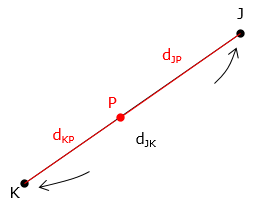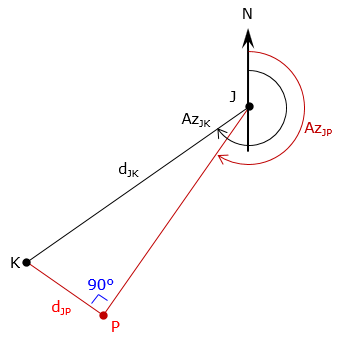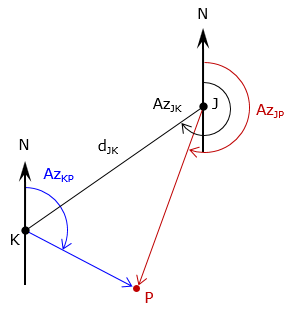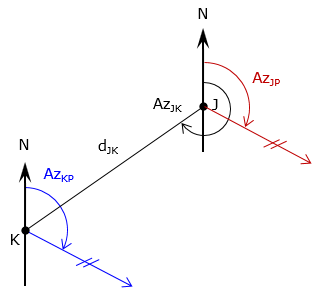5. Intersections
a. Solution logic
Determining the position of an unknown point requires a combination of triangle solutions along with inverse and Forward Computations. Two points with known coordinates (A and B) form one side of a triangle; inversing between them gives the length and direction of that side (the base line), Figure C-22.
|
|
|
Fig C-22 |
Recall that three parts of a triangle, including one side, must be known to compute the other parts. Performing an Inverse Computation between the two known points fixes one side of the triangle. The other two parts come from the measurements connecting the unknown point with the base line. Using the Law of Sines or Cosines, enough additional triangle parts are computed to connect the unknown point to a known point with a distance and direction. The unknown coordinates can then be computed using a Forward Computation.
In each of the following intersection descriptions:
- Points J and K have known coordinates and define the base line
- P is the unknown point whose position is being determined
The first step in each intersection is to inverse between points J and K to determine the base line's length and direction, thus fixing one side of the triangle and its orIentation with respect to north. The final step is a Forward Computation from one end of the base line to the unknown point. Either end of the base line may be used, computing from the other could serve as a math check.
b. Distance-distance
Distances from points J and K to point P (dJ and dK) are known, Figure C-23.
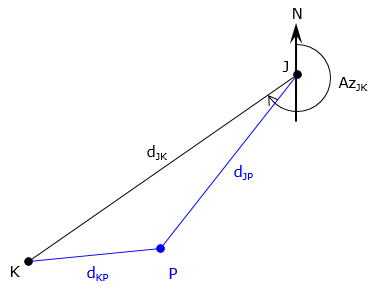 |
| Figure C-23 Distance-distance intersection |
A distance-distance intersection results in two possible locations, Figure C-24.
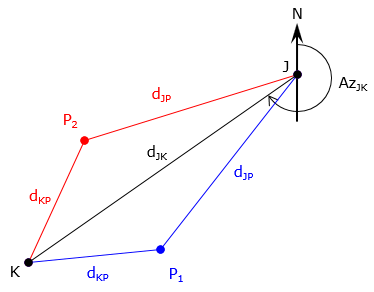 |
| Figure C-24 Two intersection points |
Triangles JKP1 and JKP2 are mirror images: they have identical angles and distances. It's up to the surveyor to decide which point intersection point, P1 or P2 , to be solve. This mirror triangle situation is the reason it's difficult to determine the unknown position using simultaneous solution of Equations B-1 and B-2. The azimuth from Point J to point P is:
|
|
Equation C-7 |
where J is the angle at point J between the base line and the line to point P.
It's relatively simple using triangle equations to solve for point P once we know which side of the base line it is.
We'll solve for point P1, Figure C-25, using a Forward Computation from point J at the base line end. We already know the distance dJP, the direction AzJP is needed.
 |
| Figure C-25 Distance-distance solution |
Solution process
Set up the Law of Cosines and rearrange it to compute angle Q
![]()

Compute azimuth, AzJP , from point J to the intersection point. Because point P is to the left of the base line, Equation C-7 becomes:
![]()
Forward compute from point J
![]()
Comments
What would change had we wanted the position of point P2 instead of point P1? Angle J would be the same except it's right of the base line instead of right. Equation C-7 would be:
![]()
In order for there to be an intersection point, (dJP + dKP) must be greater than dJK. If (dJP + dKP) = dJK then the intersection point is on the base line and the trianlge is a straight line, Figure C-26.
|
|
|
Figure C-26 |
c. Direction-distance
Direction from one control point (AzJP), and distance from the other (dKP) are known, Figure C-27.
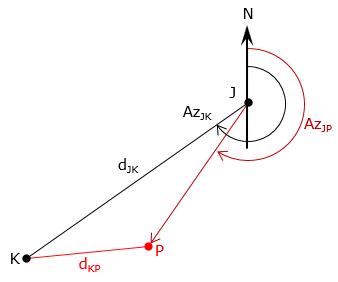 |
| Figure C-27 Direction-distance intersection |
Let's determine the position of point P using a Forward Computation from point J. To do so, we need the distance dJP. We know two sides (dJK and dKP) and the angle at point J which can be calculated from the two directions AzJK and AzJP. The simplest way to sovle dJP is using the Law of Sines which requires the angle at K.
The solution process is:
Compute angle J by finding the difference between the base line direction (AzJK) and direction to Point P (AzJP). The smaller direction is subtracted from the larger. In this case:
![]()
Determine the angle at P using the Law of Sines

Remember that we have to be careful using the Law of Sines to compute an angle because it is ambiguous: the angle can be P or 180°-P. Figure C-28 shows the two different possible triangles. Distance dKP can intersect the direction AzJP at two locations.
 |
| Figure C-28 Direction-distance two intersections |
We have to pick point P1 or P2 based on whether the angle P is acute (<90°) or obtuse (90°) which depends on the particular situation.
Once the correct angle P is selected, angle K is computed from the angle condition
![]()
Distance dJP is determined from the Law of Sines

Finally, forward compute from point J to get the coordinates
![]()
Comments
If angle P is exactly 90° a direction-distance intersection will have only a single intersection point, Figure C-29.
|
|
| Figure C-29 Direction-distance single intersection condition |
d. Direction-direction
Directions from points Q and R to point P (AzQ, and AzR) are known, Figure C-30.
|
|
|
Figure C-30 |
Two directions intersect at only a single point so there are no multiple solutions for this method. We'll look at computing point P's coordinates as a Forward Computation from point J.
The process is:
Compute angle J as the difference between AzJP and base line azimuth AzJK
Compute angle K as the difference between AzKP and base line back-azimuth AzKJ = (AzJK±180°)
Compute angle P using the angle condition.
![]()
Use Law of Sines to solve distance from point J to point P

Forward compute from J
![]()
Comments
The closer AzJP and AzKP values are to each other, the further away their intersection will be; if the two azimuths are parallel, then no intersection is possible, Figure C-31.
|
|
|
Figure C-31 |
Direction-direction is the only method which has a single intersection point. The other two methods involve at least one distance which result in two possible intersections.

